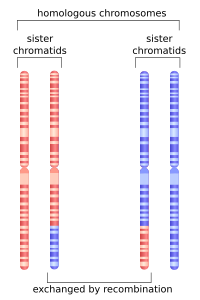
Photo from wikipedia
Abstract In bacteria, repair of DNA double-strand breaks uses a highly conserved helicase–nuclease complex to unwind DNA from a broken end and cut it at specific DNA sequences called Chi.… Click to show full abstract
Abstract In bacteria, repair of DNA double-strand breaks uses a highly conserved helicase–nuclease complex to unwind DNA from a broken end and cut it at specific DNA sequences called Chi. In Escherichia coli the RecBCD enzyme also loads the DNA strand-exchange protein RecA onto the newly formed end, resulting in a recombination hotspot at Chi. Chi hotspots regulate multiple RecBCD activities by altering RecBCD’s conformation, which is proposed to include the swinging of the RecB nuclease domain on the 19-amino-acid tether connecting the helicase and nuclease domains. Here, we altered the tether and tested multiple RecBCD activities, genetically in cells and enzymatically in cell-free extracts. Randomizing the amino-acid sequence or lengthening it had little effect. However, shortening it by as little as two residues or making substitutions of ≥10 proline or ≥9 glycine residues dramatically lowered Chi-dependent activities. These results indicate that proper control of RecBCD by Chi requires that the tether be long enough and appropriately flexible. We discuss a model in which the swing-time of the nuclease domain determines the position of Chi-dependent and Chi-independent cuts and Chi hotspot activity.
Journal Title: Nucleic Acids Research
Year Published: 2019
Link to full text (if available)
Share on Social Media: Sign Up to like & get
recommendations!